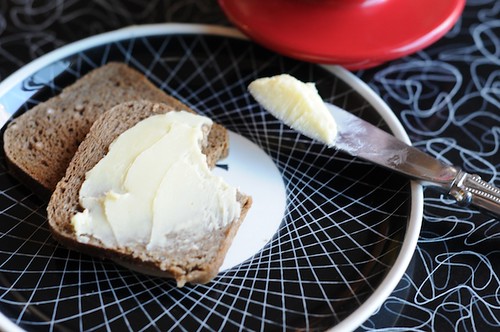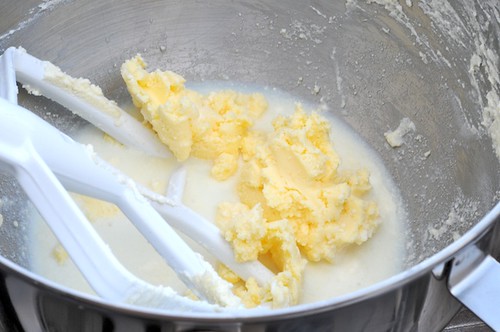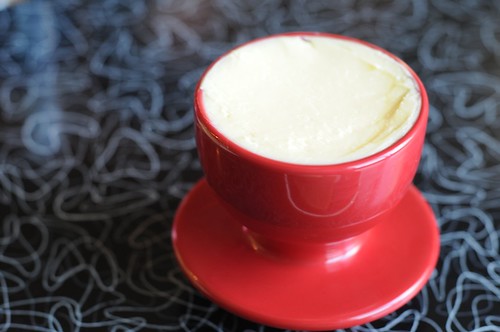I have made butter. Behold my amazing powers.
My friend Karen Solomon's latest work, Jam It, Pickle It, Cure It: And Other Cooking Projects, is the sort of book that keeps me in the kitchen far too much. It's chockablock with nifty, crafty food projects that are my idea of fun. A recent review on Eat Me Daily states that, "her book owes adebt to depression-era canning pamphlets as much as to the punkdomesticity of the hipster DIY movement." Punk domesticity, indeed. In fact, Karen's apron has skulls.
Count us in on the hipster DIYism. The day I brought home the book, I opened the fridge to note three kinds of housemade pickles plus another destined to become relish; preserved lemons; and a couple open jars of preserves (strawberry, apricot), to say nothing of the dozens of unopened jars in the pantry. There's our limoncello in the freezer, plus batches of Buddha's-handcello and pompelmocello in process. We make our own condiments and are obsessive canners. Two years ago we canned 80 pounds of tomatoes, and last year 100 pounds; next month we will take on 200 pounds. It's not uncommon for us to spend an entire Sunday in the kitchen, only to have to order a pizza for dinner because, though we have cooked for hours at a stretch, there is nothing that adds up to a meal.
And now, in our latest back-to-the-source obsession, we are making butter.
Now, how is it we can have been on this earth nearly 40 years and never knew that making butter is so utterly, totally easy? Why have we been suckered into shelling out major coin for highfalutin European or artisanal local butter? Why isn't everyone making it, all the time? I don't know, but I do know may well never buy butter again.
In point of fact, anyone who's ever made whipped cream may have gotten pretty close to making butter completely by accident. Butter is produced when the fat globules in cream are brought together by way of agitation, causing them to merge and separate from the thinner buttermilk.
Karen's book calls for the old-school method of shaking the cream until the butter comes. I am not such a patient man, nor do I have the tricep stamina to shake a jar of cream for 30-40 minutes. I prefer to let the stand mixer do the work, even though I am told it makes for an inferior product. Yeah, well, my five-minute Kitchenaid butter still kicks mass-market butter's butt, so I'll take it.
It all starts with cream, just cream; a quart will make a pound of butter. You'll want it cool, but not too much so. Too cold, and it will take quite a bit longer to come together; warmer cream will turn to butter much more quickly, but will be too soft and may make it hard to remove all the buttermilk. About 55ºF, cool to the touch, should be fine.
Make sure you have the balloon whisk attachment on your stand mixer (but keep the paddle attachment handy), and pour the cream into the bowl. Tip: wrap plastic wrap around the mixer, covering the exposed space between the bowl and the appliance itself, lest you find yourself covered in spatters of cream. Your mixer thusly wrapped, turn it on to the highest setting.
Almost instantly, you'll have whipped cream. After a couple minutes, you'll have overwhipped cream. And so it will stay for what seems like too long. Finally, when you think it's never going to happen, the butter will start to separate from the buttermilk; you'll see chunks of butter floating in a pool of translucent liquid. Stop the mixer, and switch to the paddle attachment. Turn back on a medium-low setting until the butter fully separates from the buttermilk, just a minute or two.
Pour off the buttermilk and reserve it; it'll keep a few days in the fridge, and can be used for biscuits, pie crusts, whatever you use buttermilk in. With a large spatula, knead the butter against the side of the bowl by pressing and folding it to squeeze out all the buttermilk; pour that off as you go.
When there is no more buttermilk oozing from the butter, it's ready to be turned out. Portion it as you like, perhaps in 1/4-pound blocks. Wrap it tightly in plastic wrap to store in the fridge, or vacu-seal and freeze for longer storage. Be sure to keep some of the soft butter in your Butter Bell Crock
Variations:
- When the butter is kneaded, before turning out, add 1/4 teaspoon of salt to make salted butter. This will keep better, but may not be appropriate for all uses.
- For cultured butter, mix your quart of cream with 1/3 cup plain yogurt (must have live cultures) and let stand on the counter, covered with a towel, overnight or until it thickens. Then proceed as normal. Cultured butter has a pleasant tang.
- For compound butter, mix in herbs, garlic or whatever you like during the kneading process.
Related:
I followed Drew's exquisitely drafted instructions for cultured butter.
The Wednesday Chef also finds it's better with (homemade) butter.
Don't forget to buy Karen's book!



